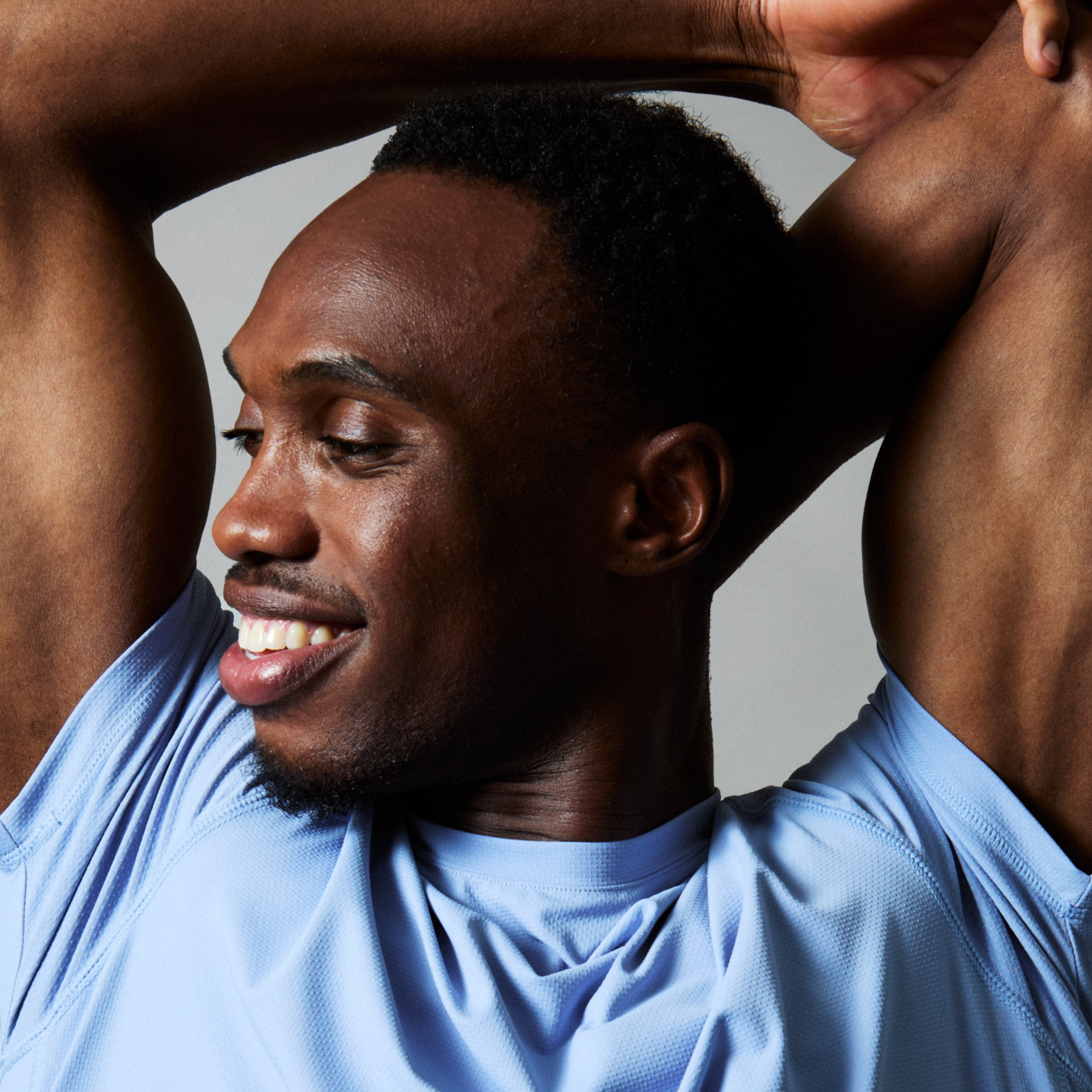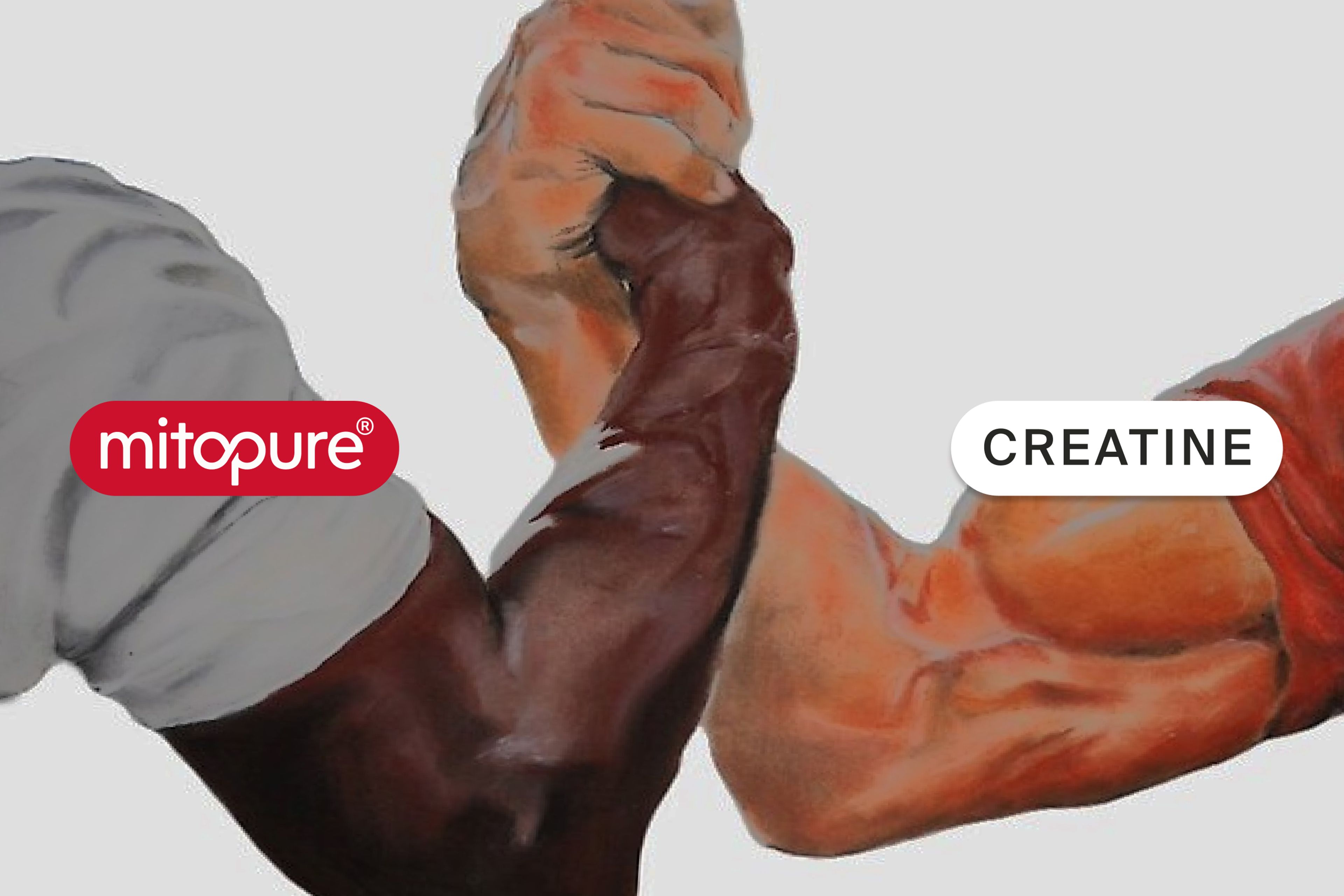How Strength, Balance & Mobility Predict Longevity
Discover how strength, balance, and mobility reveal physical longevity along with tips to test and improve vitality with science-backed strategies.
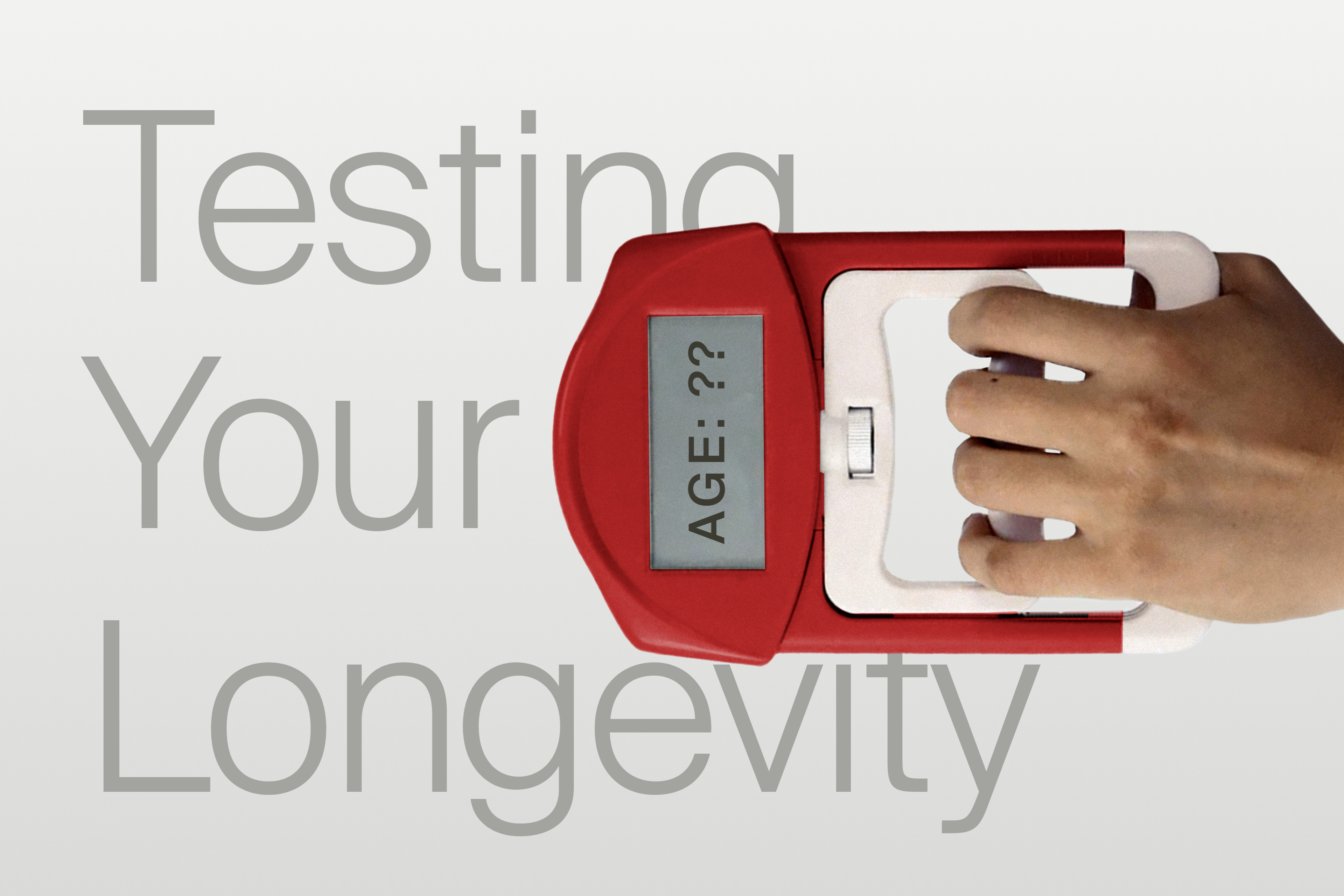
What to know
Strength, balance, and mobility are key physical markers of longevity, strongly linked to life expectancy and quality of life.
Muscle health, joint mobility, and balance influence independence and reduce risks like falls and fractures.
Functional tests such as grip strength and gait speed provide insights into physical performance and overall health.
Strength training can improve mitochondrial health, enhance resilience, and combat frailty as we age.
Mitopure® is clinically proven to boost muscle strength, supporting physical longevity at the cellular level.
In today’s world, we have more tools than ever to understand healthy aging. Blood tests, biological age assessments, and genetics offer valuable perspectives on our internal health and risk factors. While insightful, these biological markers may not tell the whole story.
That’s where physical markers come in.
Indicators like strength, balance, and mobility can give us a sense of physical functionality. They predict our independence, and they’ve been shown to powerfully correlate with life expectancy and its quality. Plus, they can easily be done by yourself, either at home or in a gym.
In this guide, we’ll explore physical indicators of longevity, including strategies to test and improve your current status for a vibrant, independent future.
Disclaimer: Some risk may occur with taking these tests; please perform them in a safe place under the guidance of a healthcare professional. Check with your healthcare provider before starting or changing your physical activity program.
Am I Aging?
For many of us, the changes in our muscles, body composition and joints are the first thing we notice as we get older. We fatigue more easily, our joints creak and ache, and we don’t bounce back from a physical strain the way we used to.
As we age, our bodies undergo numerous morphological and physiological changes that impact the musculoskeletal system. These biological changes start earlier than one might think. For example, muscle decline can happen as early as our thirties![1]
Some of the physiological changes that occur with age include:
- Muscle: Several factors contribute to muscle aging and sarcopenia, including hormonal fluctuations, inflammation and reduced protein synthesis. Mitochondrial decline also plays a role. As our mitochondria collect more damage with age, we lose muscle mass, and muscle fibers lose their ability to regenerate efficiently. This leads to reduced strength and endurance, making tasks like lifting, climbing, or even walking more challenging.[2]
- Joints: Collagen decline can affect cartilage, the cushioning material in our joints, resulting in joint pain, stiffness, and decreased flexibility, reducing overall range of motion.[3]
- Bone: Osteoporosis is a multifaceted disease characterized by progressive loss of bone density. Diet, hormones, lack of exercise and certain medications are just a few of the factors that can contribute to the development of this disease. Surprisingly, age-related mitochondrial dysfunction also impacts bone health. This makes our bones more fragile and susceptible to fractures, even with minor falls or impacts.
- Balance: Aging affects the body's ability to sense its position in space (proprioception), which is critical for maintaining balance. Reduced muscle strength, slower reflexes, and sensory changes can impair balance, making falls more likely.[4]
- Tissues: As collagen declines with age, tendons lose elasticity and become stiffer, which increases the likelihood of injuries like sprains or strains. Ligaments help stabilize joints and weaken them, making them more vulnerable to dislocation or damage and reducing overall mobility.[5]
Connective tissues like the iliotibial (IT) band, which runs along the outer side of the leg, can tighten with age, leading to discomfort. Tight connective tissues can also restrict flexibility, especially during physical activity or prolonged sitting.
Taking proactive steps now to care for our bodies can slow down, or even prevent, many of these age-related declines, ensuring that we remain strong, active, and resilient as we age.
Physical indicators of longevity are a good way to assess your current level of musculoskeletal health.
What Are Physical Indicators for Longevity?
Research indicates that certain capabilities, mainly strength, balance, and mobility, are linked to better quality of life and lower risk of age-related diseases. Functional tests, like grip strength assessments, gait speed measurements, or balance exercises, can help us identify where we fall in these categories and can[6] be used to help assess your biological age.
Let’s start by measuring our strength!
Strength Indicators for Longevity
With frailty being one of the strongest predictors of healthspan and mortality, the association between strength and longevity is closely linked[7]. Critical transitions like andropause and menopause can also accelerate muscle loss in the body.
Grip Strength
Grip strength is one of the simplest yet most powerful predictors of health in older adults. It reflects the body’s overall muscle mass and endurance and provides insight into cardiovascular health. Research has shown that weaker grip strength is associated with increased mortality and a higher risk of developing heart disease and other chronic conditions.[8]
How to test: Testing grip strength is straightforward, typically using a hand dynamometer, a tool that measures the force applied when squeezing. These low-cost tools are widely available online and will come with a chart to help you determine if your grip strength is in a healthy range.
Leg Strength
Leg strength is essential for movement. It directly impacts our ability to perform daily activities like standing, walking, and climbing stairs. Stronger leg muscles help reduce the risk of falls, one of the leading causes of injury in older adults.[9]
How to test:
The sit-to-stand test (rising from a chair without using hands) is an excellent way to assess leg strength and endurance, reflecting how much control we have over our movements.[10] To do this test, simply sit in a chair with your arms crossed over your chest and rise to stand without using your hands to help you get up. Repeat for 30 seconds, and keep track of how many repetitions you can do.[11]
Scoring:
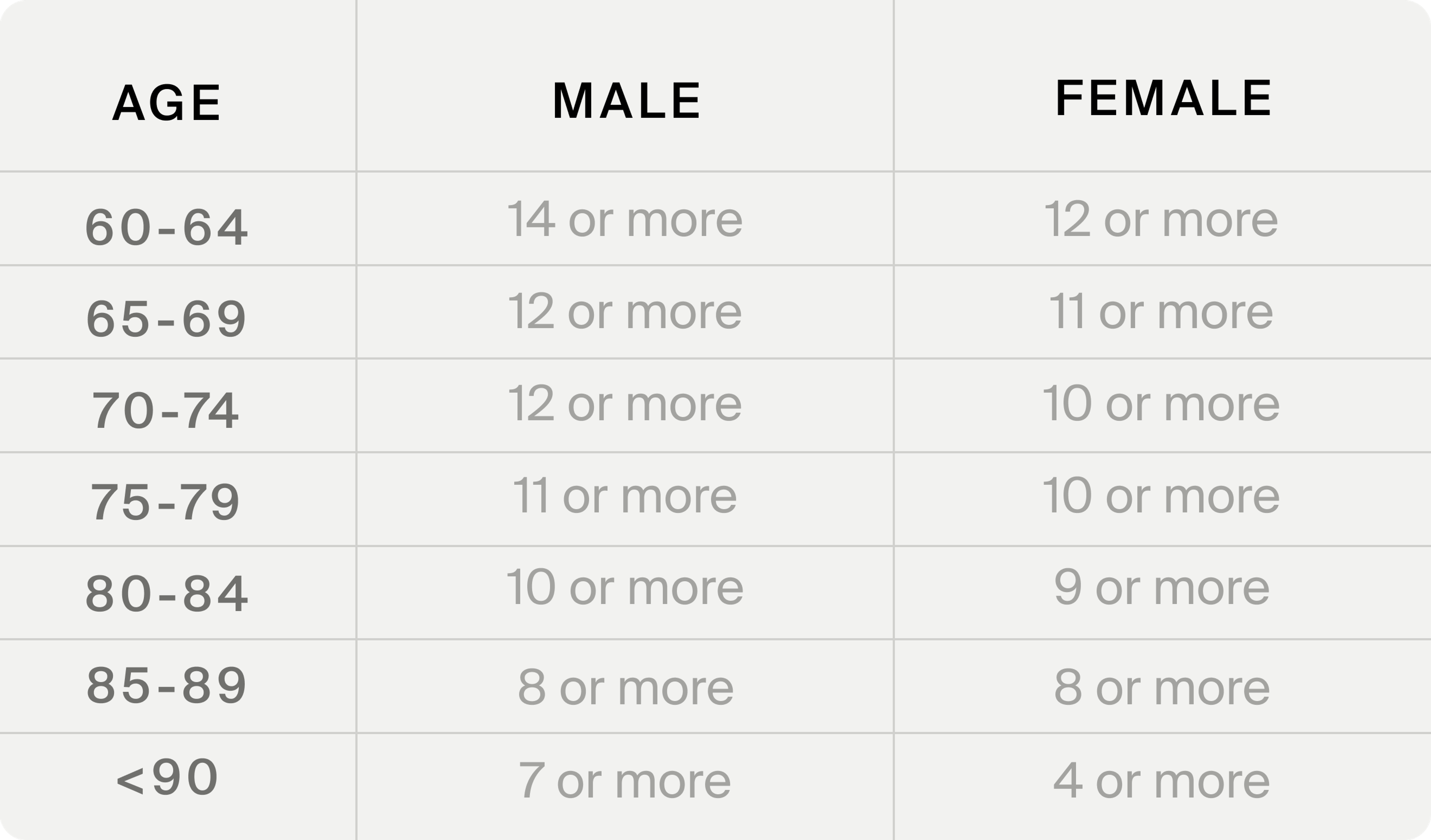
Strength Training for Longevity
If these tests for muscle health demonstrate that you have some room for improvement, there are several safe and effective ways you can help to build your muscle strength.
Working with your healthcare provider and a certified personal trainer can help you to safely regain strength.
Get Strong With Mitopure®
Dietary supplements can also help improve muscle strength and endurance.
Mitopure®, a highly pure form of Urolithin A, isn’t just another supplement; it’s a powerful bioactive molecule with 15 years of research backing its safety and efficacy.
By supporting mitophagy, the process of recycling damaged mitochondria, Mitopure® ensures that your cells remain energized and capable of supporting physical performance.
Two pivotal clinical trials have demonstrated how 1000mg of Mitopure® taken daily can improve muscle endurance, and 500mg of daily Mitopure® can build strength without requiring more exercise.[12]
The Energize Trial:
This randomized, double-blind, placebo-controlled clinical trial, published in JAMA Network, focused on older adults. The study found that daily intake of 1000mg of Mitopure® significantly improved muscle endurance. Individuals experienced a 26% increase in hand endurance and a 17% increase in leg endurance after 8 weeks of use. No changes to diet or exercise were part of this study.[13]
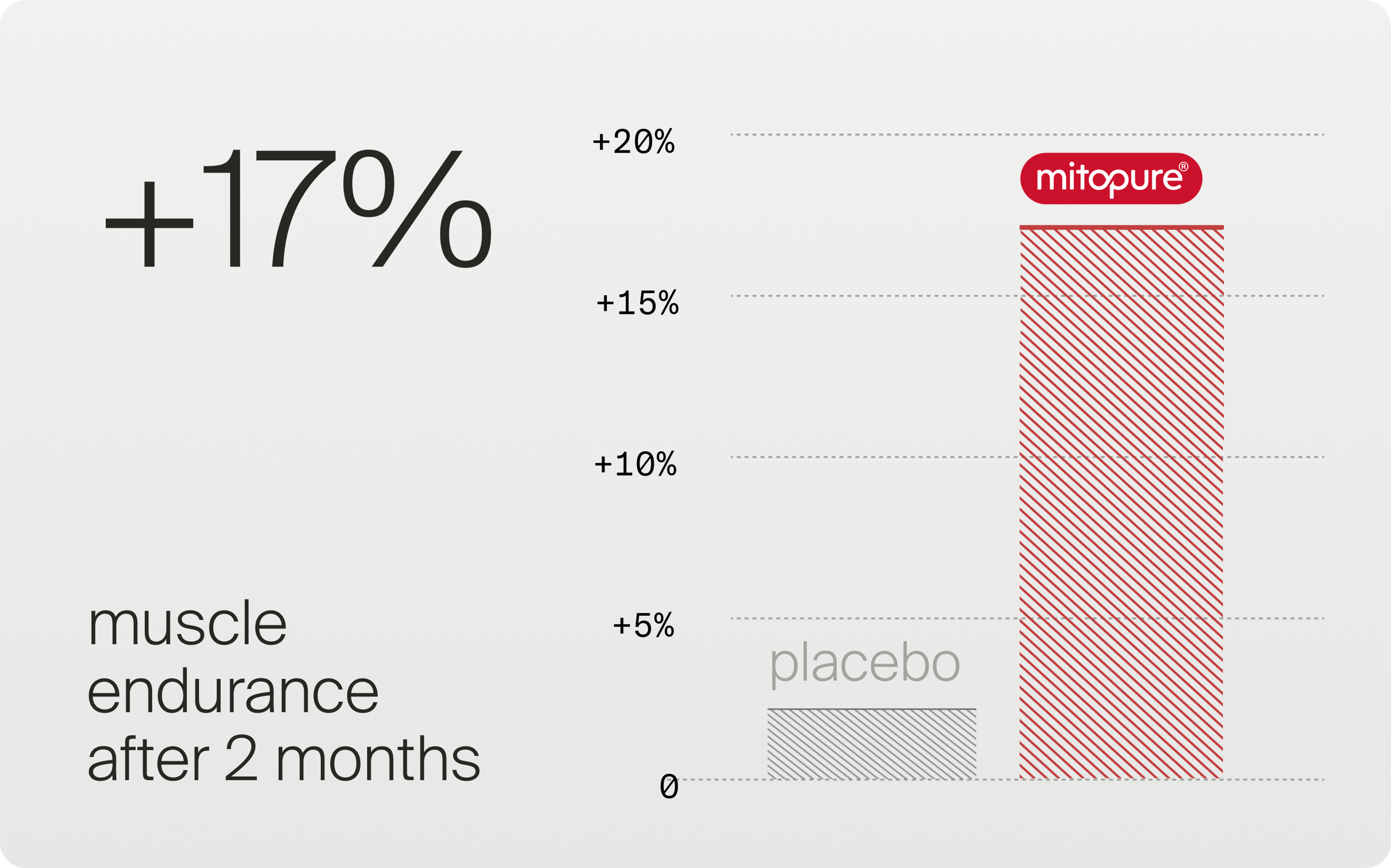
The ATLAS Trial:
Published in Cell Reports Medicine, this randomized, placebo-controlled study examined the effects of taking 500mg and 1000mg of Mitopure® daily on muscle function and physical performance in healthy middle-aged adults.
The trial found that Urolithin A supplementation significantly improved hamstring leg muscle strength by 12% after 16 weeks of use. It also notably improved hand grip strength by 5.1%. Again, no changes in diet or exercise were part of the study design.[14]
The results of these two studies suggest that a daily intake of 500mg or 1000mg Mitopure® may be a safe and effective way to bolster muscle strength, while a daily intake of 1000mg may also increase endurance.

Mitopure Softgels
Bestseller4.4 · 3103 reviews
The simplest form of Mitopure
Balance Biomarkers of Longevity
Falls are the leading cause of injury-related death in seniors.[15] As our bodies lose functionality and our musculoskeletal system becomes increasingly prone to injury, balance becomes a must.
The Old Man Test
Poor balance increases the risk of falls and injuries, which can significantly limit independence. The 'Old Man Test' is an informal yet effective assessment of balance, strength, flexibility, and control, making it a valuable indicator of longevity.
What Does the Old Man Test Prove? While direct research on this specific test is limited, studies suggest that the ability to stand on one leg for 10 seconds is a strong predictor of survival in both middle-aged and older adults.
How to test: Rules for the old man test are easy. Stand on one leg and time how long you can maintain balance. Aim for at least 10-15 seconds. Social media content creators have their own twist on this, where you stand on one leg long enough to put on your sock and shoe.
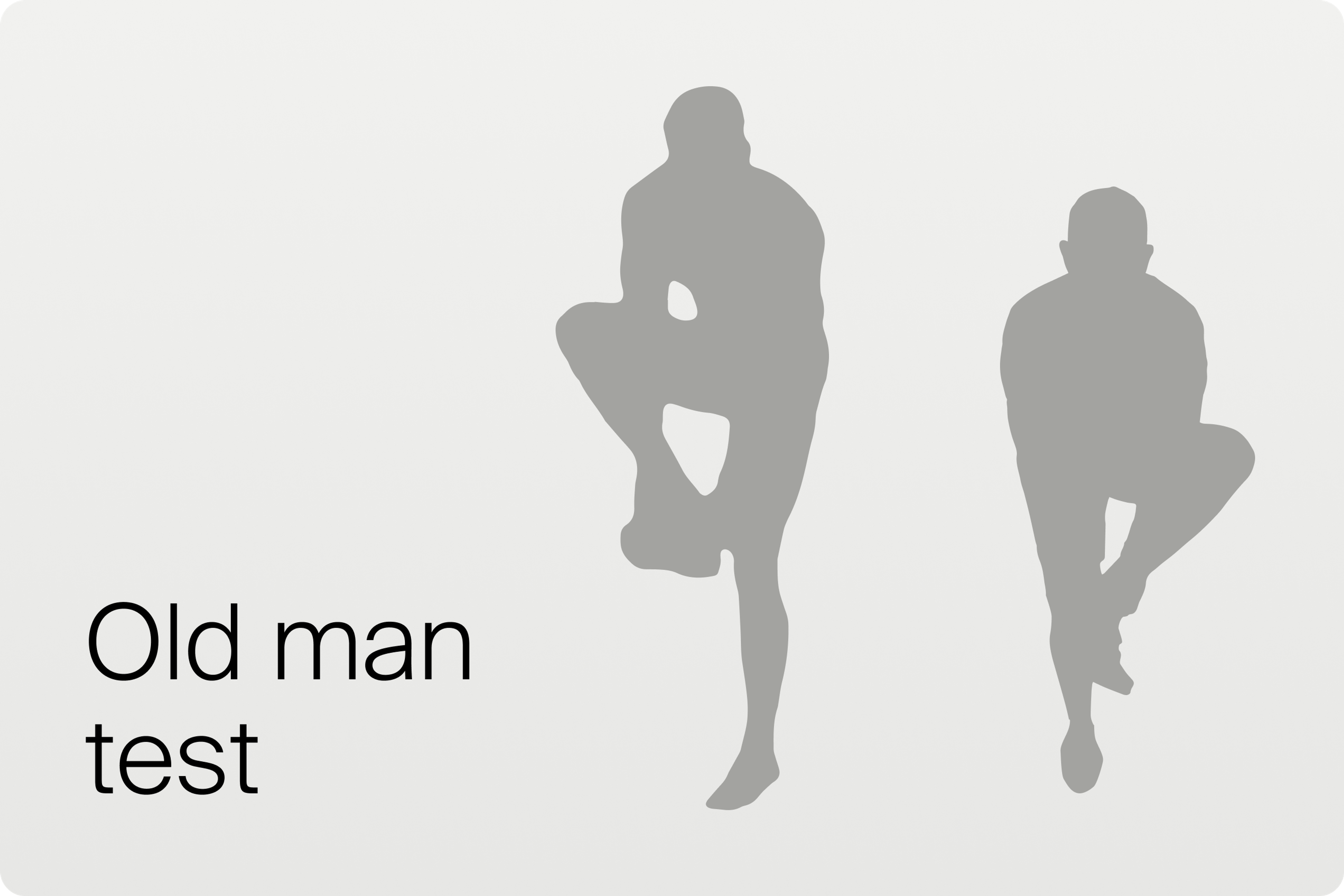
Functional Reach Test
The Functional Reach Test measures postural control and stability. It’s an indicator of fall risk, making it particularly valuable for older adults. Shorter reach distances often point to poor dynamic balance and an increased risk of falls.[16]
How to test: The test involves reaching forward while standing still without losing balance. Measure how far you can reach comfortably. Those who can reach further distances usually have better balance and mobility.
Scoring:
- If you can reach 10 inches (25 cm) or more you have a low risk of falls
- If you can reach 6 inches (15cm) to 10 ,(25cm), your risk of falling is 2x greater than normal;
- If you can reach 6 inches (15cm) or less, your risk of falling is 4x greater than normal
- If you are unable to reach at all, your risk of falling is 8x greater than normal.[17]
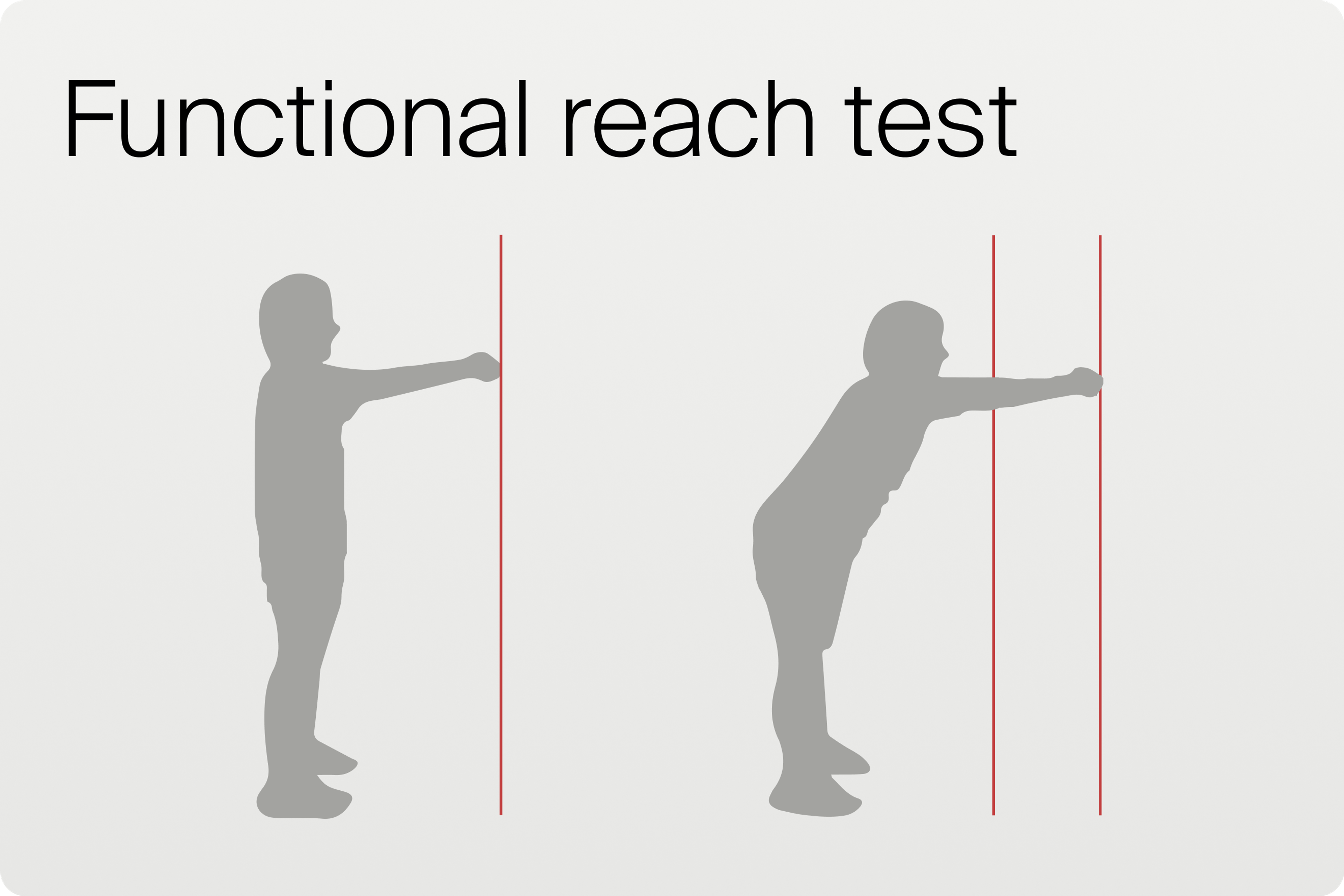
Balance Training for Longevity
As we lose muscle and our muscle-brain connection weakens, it gets harder to balance with age. Fortunately, balancing exercises can help you regain control of your movement. Activities like yoga, tai chi, and dancing not only promote stability but also enhance overall coordination.[18] For a fun, balance-boosting sport, try pickleball!
While balance exercises are essential, building strength is what’s really going to help with stability[19]. Focus on moves that target your core, hips, and legs to build a strong foundation.
Mobility Biomarkers for Longevity
Functionality and flexibility are powerful indicators of quality of life. Joint mobility, stretchability, and durability are critical for our independence.
Gait Speed
Walking speed is the most frequently recorded biomarker in literature. Studies have found that slower gait speeds, particularly speeds under 0.8 meters per second, are associated with higher mortality rates. This is because walking speed reflects cardiovascular health, muscle strength, and balance.[20]
How to test: A simple 4-meter walk timed at a normal pace can provide an accurate assessment of gait speed. Divide the distance (4 meters) by the time it took you to walk (in seconds). This can also be recorded with an Apple Watch or FitBit.
Scoring:
A healthy gait speed is between 0.8–1.2 m/s or faster.[21]
Timed Up-and-Go Test
The Timed Up-and-Go (TUG) test is another reliable predictor of physical function and independence. This can be done at home with a standard chair. Slow TUG times are significantly linked to adverse health outcomes in adults.[22]
How to test: The test requires you to rise from a chair, walk a 3-meter distance, and return to the chair, timing your movements to assess overall mobility.
Scoring:
Anytime below 10 seconds is normal; an older adult who takes ≥12 seconds is at risk for falling.[23]
Sit and Reach Test
The Sit and Reach Test (SRT) tests flexibility and joint health. This particular test measures hamstring and lower back flexibility. Avoid straining too much during this test to avoid overstretching.
How to test: In an office, this test is usually done with a box-like device with a measuring stick attached.
At home, sit on the floor with your legs extended and heels against a wall. Reach forward with both hands toward your toes, keeping your knees straight, and hold for 1–2 seconds. Measure the distance using a ruler.
Scoring:
Average reach ability is 23 cm for men and 29 cm for women. Significantly below that range means you may have low flexibility in your back and hamstrings.[24]
Mobility Training for Longevity
Regularly incorporating activities such as stretching, yoga, and targeted mobility exercises into your workout routine can enhance flexibility, joint health, and overall movement quality. [25]These practices not only support daily activities but also help reduce the risk of injury.
Additional Physical Indicators of Longevity
Outside of strength, balance, and mobility, there are many other indicators of longevity. Some honorable mentions include:
- Body Composition: Assesses the ratio of muscle, fat, bone, and tissue to support metabolic health, tested via impedance scales or DEXA scans. Typically, the focus is on minimizing the visceral fat surrounding the abdominal organs.[26]
- VO2 Max: Measures cardiovascular and aerobic fitness, with higher levels linked to reduced heart disease risk; tested via treadmill, cycle tests, or fitness trackers.[27]
- Heart Rate Variability (HRV): Reflects stress resilience and nervous system health, with higher values showing better adaptability; measured using smartwatches or HRV apps.[28]
Need a Training Boost?
As we age, maintaining an active lifestyle can become increasingly challenging—not because of a lack of willpower, but due to changes happening deep within our cells. The decline of mitochondrial efficiency leads to reduced cellular energy. This shift contributes to fatigue and diminished physical performance.[29]
Mitopure® offers a scientifically validated solution to combat this decline. Our clinical trial found that after 4 weeks, participants who received a daily dose of Mitopure (Urolithin A) significantly improved mitochondrial signature compared with participants in the placebo group.[30]
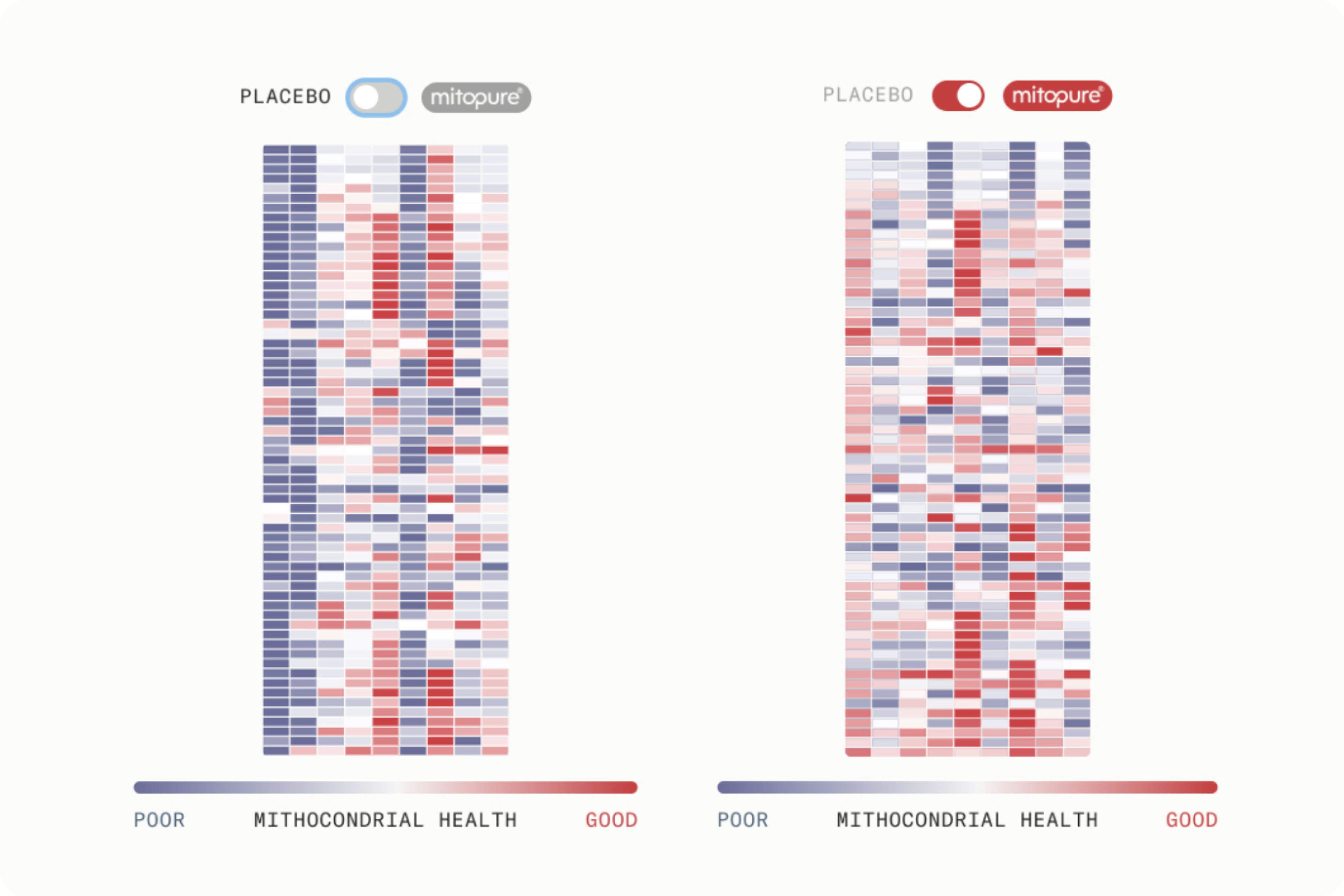
Clinical studies demonstrate that 500mg or 1000mg of Mitopure® taken daily can significantly improve muscle strength, while 1000mg of daily Mitopure® increases endurance, without the need for more exercise. This makes it an ideal choice for those looking to maintain vitality, fight frailty, and sustain mobility as they age. Mitopure® helps you live healthier, longer.[31]
Authors

Written by
Freelance writer

Reviewed by
Senior Manager of Nutrition Affairs
References
- ↑
Keller, K., & Engelhardt, M. (2019). Strength and muscle mass loss with aging process. Age and strength loss.. Muscles, ligaments and tendons journal, 3 4, 346-50 . https://doi.org/10.32098/MLTJ.04.2013.17 (https://www.google.com/url?q=https://doi.org/10.32098/MLTJ.04.2013.17&sa=D&source=docs&ust=1737150794136316&usg=AOvVaw3pXlA-WBoVgVvHABHOZf5F).
- ↑
Konopka, A. R., & Sreekumaran Nair, K. (2013). Mitochondrial and skeletal muscle health with advancing age. Molecular and cellular endocrinology, 379(1-2), 19–29. https://doi.org/10.1016/j.mce.2013.05.008
- ↑
Shane Anderson, A., & Loeser, R. F. (2010). Why is osteoarthritis an age-related disease?. Best practice & research. Clinical rheumatology, 24(1), 15–26. https://doi.org/10.1016/j.berh.2009.08.006
- ↑
Cao, C., Cade, W. T., Li, S., McMillan, J., Friedenreich, C., & Yang, L. (2021). Association of Balance Function With All-Cause and Cause-Specific Mortality Among US Adults. JAMA otolaryngology-- head & neck surgery, 147(5), 460–468. https://doi.org/10.1001/jamaoto.2021.0057
- ↑
Kwan KYC, Ng KWK, Rao Y, Zhu C, Qi S, Tuan RS, Ker DFE, Wang DM. Effect of Aging on Tendon Biology, Biomechanics and Implications for Treatment Approaches. Int J Mol Sci. 2023 Oct 14;24(20):15183. doi: 10.3390/ijms242015183. PMID: 37894875; PMCID: PMC10607611.
- ↑
Manca, A., Fiorito, G., Morrone, M., Boi, A., Mercante, B., Martinez, G., Ventura, L., Delitala, A. P., Cano, A., Catte, M. G., Solinas, G., Melis, F., Ginatempo, F., & Deriu, F. (2023). A novel estimate of biological aging by multiple fitness tests is associated with risk scores for age-related diseases. Frontiers in physiology, 14, 1164943.
- ↑
Ge, M. L., Simonsick, E. M., Dong, B. R., Kasper, J. D., & Xue, Q. L. (2021). Frailty, With or Without Cognitive Impairment, Is a Strong Predictor of Recurrent Falls in a US Population-Representative Sample of Older Adults. The journals of gerontology. Series A, Biological sciences and medical sciences, 76(11), e354–e360.
- ↑
Bohannon R. W. (2019). Grip Strength: An Indispensable Biomarker For Older Adults. Clinical interventions in aging, 14, 1681–1691.
- ↑
Gillespie, L. D., Robertson, M. C., Gillespie, W. J., Sherrington, C., Gates, S., Clemson, L. M., & Lamb, S. E. (2012). Interventions for preventing falls in older people living in the community. The Cochrane database of systematic reviews, 2012(9), CD007146.
- ↑
Shukla, B., Bassement, J., Vijay, V., Yadav, S., & Hewson, D. (2020). Instrumented Analysis of the Sit-to-Stand Movement for Geriatric Screening: A Systematic Review. Bioengineering,
- ↑
"30-Second Chair Stand." Centers for Disease Control and Prevention, www.cdc.gov/steadi/media/pdfs/STEADI-Assessment-30Sec-508.pdf. Accessed 9 Dec. 2024.
- ↑
Liu, S., D'Amico, D., Shankland, E., Bhayana, S., Garcia, J. M., Aebischer, P., Rinsch, C., Singh, A., & Marcinek, D. J. (2022). Effect of Urolithin A Supplementation on Muscle Endurance and Mitochondrial Health in Older Adults: A Randomized Clinical Trial. JAMA network open, 5(1), e2144279. https://doi.org/10.1001/jamanetworkopen.2021.44279
- ↑
Liu, S., D'Amico, D., Shankland, E., Bhayana, S., Garcia, J. M., Aebischer, P., Rinsch, C., Singh, A., & Marcinek, D. J. (2022). Effect of Urolithin A Supplementation on Muscle Endurance and Mitochondrial Health in Older Adults: A Randomized Clinical Trial. JAMA network open, 5(1), e2144279. https://doi.org/10.1001/jamanetworkopen.2021.44279
- ↑
Singh, A., D'Amico, D., Andreux, P. A., Fouassier, A. M., Blanco-Bose, W., Evans, M., Aebischer, P., Auwerx, J., & Rinsch, C. (2022). Urolithin A improves muscle strength, exercise performance, and biomarkers of mitochondrial health in a randomized trial in middle-aged adults. Cell reports. Medicine, 3(5), 100633.
- ↑
Santos-Lozada A. R. (2023). Trends in Deaths From Falls Among Adults Aged 65 Years or Older in the US, 1999-2020. JAMA, 329(18), 1605–1607.
- ↑
Segal, A. D., Vargas, B. L., Richards, F. G., Shelley, C. J., & Silverman, A. K. (2023). Healthy aging reduces dynamic balance control as measured by the simplified Star Excursion Balance Test. Gait & posture, 103, 190–195.
- ↑
"Functional Reach Test (FRT)." Physiopedia, www.physio-pedia.com/Functional_Reach_Test_(FRT). Accessed 9 Dec. 2024.
- ↑
Bahramian, F., Abolfaz, S., -, M., Aslani, M., Ahmadinejad, B., Bayati, H., & Jalali, A. (2023). Dance-based interventions on balance and falls in the elderly in order to health promotion: a literature review. Journal of Public Health and Development.
- ↑
Wolfson, L., Whipple, R., Judge, J., Amerman, P., Derby, C., & King, M. (1993). Training Balance and Strength in the Elderly to Improve Function. Journal of the American Geriatrics Society, 41.
- ↑
Manca, A., Fiorito, G., Morrone, M., Boi, A., Mercante, B., Martinez, G., Ventura, L., Delitala, A. P., Cano, A., Catte, M. G., Solinas, G., Melis, F., Ginatempo, F., & Deriu, F. (2023). A novel estimate of biological aging by multiple fitness tests is associated with risk scores for age-related diseases. Frontiers in physiology, 14, 1164943. https://doi.org/10.3389/fphys.2023.1164943
- ↑
Schreiber, C., & Moissenet, F. (2019). A multimodal dataset of human gait at different walking speeds established on injury-free adult participants. Scientific Data, 6. https://doi.org/10.1038/s41597-019-0124-4.
- ↑
Marín-Jiménez, N., Cruz-León, C., Pérez-Bey, A., Conde-Caveda, J., Grao-Cruces, A., Aparicio, V., Castro‐Piñero, J., & Cuenca-Garcia, M. (2022). Predictive Validity of Motor Fitness and Flexibility Tests in Adults and Older Adults: A Systematic Review. Journal of Clinical Medicine, 11.
- ↑
Assessment timed up & go (TUG). Centers for Disease Control and Prevention. (n.d.). https://www.cdc.gov/steadi/media/pdfs/steadi-assessment-tug-508.pdf
- ↑
López-Miñarro, P. A., Andújar, P. S., & Rodrñguez-Garcña, P. L. (2009). A comparison of the sit-and-reach test and the back-saver sit-and-reach test in university students. Journal of sports science & medicine, 8(1), 116–122.
- ↑
Gothe, N., & McAuley, E. (2016). Yoga Is as Good as Stretching-Strengthening Exercises in Improving Functional Fitness Outcomes: Results From a Randomized Controlled Trial.. The journals of gerontology. Series A, Biological sciences and medical sciences, 71 3, 406-11 . https://doi.org/10.1093/gerona/glv127.
- ↑
Lee, D. H., & Giovannucci, E. L. (2018). Body composition and mortality in the general population: A review of epidemiologic studies. Experimental biology and medicine (Maywood, N.J.), 243(17-18), 1275–1285. https://doi.org/10.1177/1535370218818161
- ↑
Strasser, B., & Burtscher, M. (2018). Survival of the fittest: VO2max, a key predictor of longevity?. Frontiers in bioscience, 23, 1505-1516 . https://doi.org/10.2741/4657.
- ↑
Zulfiqar, U., Jurivich, D., Gao, W., & Singer, D. (2010). Relation of high heart rate variability to healthy longevity.. The American journal of cardiology, 105 8, 1181-5 .
- ↑
Lacourt, T., Vichaya, E., Chiu, G., Dantzer, R., & Heijnen, C. (2018). The High Costs of Low-Grade Inflammation: Persistent Fatigue as a Consequence of Reduced Cellular-Energy Availability and Non-adaptive Energy Expenditure. Frontiers in Behavioral Neuroscience, 12.
- ↑
Singh, A., D'Amico, D., Andreux, P. A., Fouassier, A. M., Blanco-Bose, W., Evans, M., Aebischer, P., Auwerx, J., & Rinsch, C. (2022). Urolithin A improves muscle strength, exercise performance, and biomarkers of mitochondrial health in a randomized trial in middle-aged adults. Cell reports. Medicine, 3(5), 100633. https://doi.org/10.1016/j.xcrm.2022.100633
- ↑
Singh, A., D'Amico, D., Andreux, P. A., Fouassier, A. M., Blanco-Bose, W., Evans, M., Aebischer, P., Auwerx, J., & Rinsch, C. (2022). Urolithin A improves muscle strength, exercise performance, and biomarkers of mitochondrial health in a randomized trial in middle-aged adults. Cell reports. Medicine, 3(5), 100633. https://doi.org/10.1016/j.xcrm.2022.100633

•
Nutrition•
First-of-Its-Kind Longevity Gummy Launched

•
Skincare•




